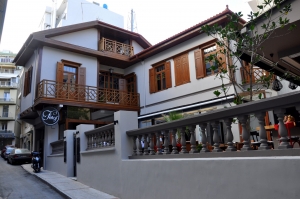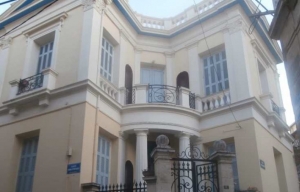The fountain is located at Michelidakis street, behind the Historical Museum of Crete. The fountain was not originally here, but adorned the exterior of the house of the doctor Idomeneas Markatatis. We can see two columns with capitals that bear performances with plants and an Ottoman inscription.
The Small Serai is located at 21 Evropis Street and was used as the residence of Little Bey, a wealthy Muslim Cretan. Today it is a privately property and operates as a restaurant.
The house of John Chronakis is a beautiful Ottoman house in the center of Heraklion, which belonged to the Bey Rasih Asprakis. It was restored in 1991 and houses various art objects. Apart from the exhibits, the visitor can see the hammam, the indoor fountain, the murals, the woodwork and rich decorations of ceilings of this excellent sample of Ottoman mansion.
This house is one of the most elegant examples of the late 'romantic' Neoclassicism. It was built in the first decade of the 20th century by the architect D. Kyriakou, probably influenced by the bilding of Stathatos at Queen Olga avenue, Athens (architect Ernst Ziller).
The deserted today Pananio Municipal Hospital was constructed at the expense of Pananos Theodoulakis and his wife Athena Anemogianni. Its construction began in 1895, but it was interrupted due to the great revolution of 1896 and restarted in November 1896, to stop again in 1897. During the Cretan State era works started again (in 1900) and on 10 February 1902 the hospital opened its gates. After the operation of the new Pananio-Venizelio general Hospital near Knossos in 1953, the hospital stopped its operation.
It is a characteristic example of the Balkan architecture with clear neoclassical influence. The size, the structure of the rooms, the variety of the forms of the other parts and the high aesthetic conception establish the building unique in Heraklion.
Opposite the Great Koules of Heraklion (Rocca al Mare), which still dominates the entrance to the Venetian port of the city, the Turks founded a smaller tower. It was the only fortification work that the Turks added to the harbor area throughout the period of their domination on the island.
The Saint George Barracks, today’s Region of Crete and former Prefecture of Heraklion, were built by the Venetians in the 16th century to quarter approximately 700 soldiers, but were later destroyed by an earthquake.






















































































